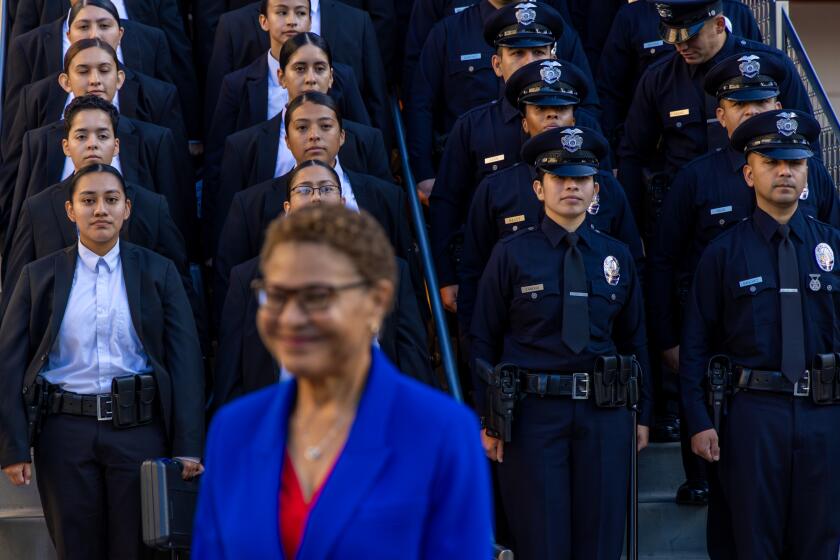O.C. Orders In Strike Teams to Quell Gangs
- Share via
SANTA ANA — Orange County moved to stiffen its defenses against mounting gang violence Tuesday with the approval of a $2-million program that will dispatch strike teams of police, prosecutors and probation officers to the county’s most troubled neighborhoods.
The Board of Supervisors unanimously endorsed the program and the addition of 23 new prosecutors and probation officers to staff gang units in Anaheim, Costa Mesa, Garden Grove, Orange and Santa Ana.
An additional team had been planned for South County, but Orange County Sheriff Brad Gates has declined to participate in the program, saying he is satisfied with current gang prosecution efforts in the seven South County cities his department patrols.
Gates’ absence was noted Tuesday as police chiefs from the five participating cities gathered for the board’s vote.
However, county officials preferred to heap praise on a program that they say holds “enormous” potential for expansion countywide.
Supervisor Roger R. Stanton, whose district includes the gang-troubled cities of Santa Ana and Garden Grove, said board’s action was tantamount to “retaking” crime-ridden urban areas.
“The solution to the gang problem is a very difficult and elusive goal,” Stanton said. “Gang members prey on frightened communities. . . . Now, we can begin to regain peace of mind and peace in our streets.”
The new anti-gang project is essentially an extension of a highly successful program in the city of Westminster known as TARGET. There, local police have been teamed in the same office with prosecutors and probation officers to build criminal cases against the community’s most hardened gang leaders.
“This is the way the Japanese build cars and the way aerospace engineers get people to the moon,” Westminster Police Chief James Cook said in a news conference following the board meeting.
Cook credited the program with a reduction of gang-related crime in the city by nearly two-thirds since last year. He pointed to a wall of charts and graphs all showing sharp declines of violent crimes such as murder, robbery and assault.
“Any way you want to slice it, gang crime is down in Westminster,” he said.
Orange County Dist. Atty. Michael R. Capizzi has led the effort to duplicate the TARGET program countywide.
With the board’s vote, an elated Capizzi said the first team will be moved into Santa Ana by Jan. 1. Special teams approved for Garden Grove, Orange, Anaheim, Costa Mesa and a second team for Santa Ana will be formed during the first half of next year. The existing Westminster plan will remain intact.
Anaheim acting Police Chief Jimmie Kennedy said he was “excited” to be participating, but warned against unrealistic expectations from government officials and residents.
“This problem did not come on us overnight,” Kennedy said, “and it is not going to go away overnight.”
The district attorney said an additional prosecutor and probation officer would be assigned to South County by June 1 to help with gang-related prosecutions. A complete unit there would require two sheriff’s deputies, but Capizzi said the “Sheriff’s Department felt it wasn’t necessary.”
Gates could not be reached for comment Tuesday. Although a majority of county gang activity takes place in central Orange County, the district attorney has estimated that nearly 800 gang members and 14 separate gangs are based in South County, where the Sheriff’s Department provides law enforcement services.
Supervisor Thomas F. Riley, whose district includes nearly all of South County, said he was concerned about his district’s lack of involvement in the program, but supported TARGET nonetheless.
“There is no doubt about the need for this program,” Riley said. “I do have some reservations that South County would not be included, but I will not stand in the way.”
More criticism came from a surprising source: soft-spoken Orange County Treasurer Robert L. Citron, who was credited with arranging critical financing for expanding TARGET countywide.
“It’s unfortunate that the sheriff has chosen not to go along with this,” Citron told supervisors before their vote. “(The sheriff) does not wish to recognize the opportunity to reduce the costs of this gang program by cooperating in the management of these funds.”
Citron said the county was able to pay for the program due to higher-than-expected interest earnings from county investments. Supervisors said there would be no need to drain money from other local government services to pay for the program.
Tuesday’s board action comes less than two weeks after the county’s first summit on gang violence, where parents and business leaders joined law enforcement and government officials in a collective call for help against encroaching local gang activity.
Authorities said gang membership in Orange County has increased dramatically to at least 17,000 members this year, a phenomenal 743% jump since 1986. Gang-related deaths stand at 72 this year, up from a record 43 killings a year ago.
And in communities long considered havens from gang violence, recent months have brought two fatal shootings at the Newport Beach Pier and the death of a popular San Clemente High School student who was speared through the head with a paint brush roller.
“Clearly, the district attorney’s plan is not the only solution to the plan,” Supervisor Gaddi H. Vasquez said Tuesday. “But I think it has a good chance. Today, we are taking some very positive strides.”
Board of Supervisors Chairman Harriett M. Wieder called the strategy an opportunity to “put money where our mouth is.”
However, one Santa Ana resident, Jaime Vega, suggested that the district attorney’s plan might mistakenly target Orange County Hispanics and Asians who are not gang members.
Vega’s comment brought a swift response from Vasquez, the board’s only Latino member.
“Whether we like it or not,” the supervisor said, pointing to Vega, “the Hispanic and Asian communities are seeing a tremendous growth in gang activity.
“We need to get away from a state of denial that we are in,” Vasquez said. “If we don’t do something, Hispanic and Asian communities will be living under siege.”
More to Read
Sign up for Essential California
The most important California stories and recommendations in your inbox every morning.
You may occasionally receive promotional content from the Los Angeles Times.










